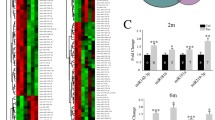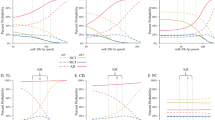Abstract
Human brain cells rely on a specific subset of microRNAs (miRNAs or miRs) to shape their gene expression patterns, and this is mediated through microRNA effects on messenger RNA (mRNA) speciation and complexity. In recent studies (a) in short post-mortem interval Alzheimer’ disease (AD) brain tissues versus age-matched controls, and (b) in pro-inflammatory cytokine- and Aβ42 peptide-stressed human neuronal-glial (HNG) cells in primary culture, we have identified several brain-abundant miRNA species found to be significantly up-regulated, including miR-125b and miR-146a. Both of these nuclear factor kappa B (NF-κB)-activated, 22 nucleotide small non-coding RNAs (sncRNAs) target the mRNA of the key, innate-immune- and inflammation-related regulatory protein, complement factor-H (CFH; chr 1q32), resulting in significant decreases in CFH expression (p < 0.01, ANOVA). Our results further indicate that HNG cells respond to IL-1β + Aβ42-peptide-induced stress by significant NF-κB-modulated up-regulation of miRNA-125b- and miRNA-146a. The complex interactive signaling of NF-κB, miR-125b, miR-146a, and perhaps other miRNAs, further illustrate interplay between inducible transcription factors and multiple pro-inflammatory sncRNAs that regulate CFH expression. The novel concept of miRNA actions involving mRNA target convergence and divergence are proposed and discussed. The combinatorial use of NF-кB inhibitors with anti-miRNAs (AMs; antagomirs) may have potential against CFH-driven pathogenic signaling in neurodegenerative disease, and may redirect our therapeutic perspectives to novel treatment strategies that have not yet been considered.




Similar content being viewed by others
References
Liang WS, Dunckley T, Beach TG, Grover A, Mastroeni D, Ramsey K, Caselli RJ, Kukull WA, McKeel D, Morris JC, Hulette CM, Schmechel D, Reiman EM, Rogers J, Stephan DA (2008) Altered neuronal gene expression in brain regions differentially affected by Alzheimer’s disease: a reference data set. Physiol Genomics 33:240–256
Li YY, Cui JG, Dua P, Pogue AI, Bhattacharjee S, Lukiw WJ (2011) Differential expression of miRNA-146a-regulated inflammatory genes in human primary neural, astroglial and microglial cells. Neurosci Lett 499:109–113
Guo H, Ingolia NT, Weissman JS, Bartel DP (2010) Mammalian microRNAs predominantly act to decrease target mRNA levels. Nature 466:835–840
Lukiw WJ (2007) Micro-RNA speciation in fetal, adult and Alzheimer’s disease hippocampus. Neuroreport 18:297–300
Lukiw WJ, Pogue AI (2007) Induction of specific micro RNA (miRNA) species by ROS-generating metal sulfates in primary human brain cells. J Inorg Biochem 101:1265–1269
Lukiw WJ, Zhao Y, Cui JG (2008) A NF-кB-sensitive miRNA-146a-mediated inflammatory circuit in AD and in stressed human brain cells. J Biol Chem 283:31315–31322
Cui JG, Li YY, Zhao Y, Bhattacharjee S, Lukiw WJ (2010) Differential regulation of interleukin-1 receptor-associated kinase-1 (IRAK-1) and IRAK-2 by miRNA-146a and NF-kB in stressed human astroglial cells and in Alzheimer’s disease. J Biol Chem 285:38951–38960
Sethi P, Lukiw WJ (2009) Micro-RNA abundance and stability in human brain: specific alterations in Alzheimer’s disease temporal lobe neocortex. Neurosci Lett 459:100–104
Deangelis MM, Silveira AC, Carr EA, Kim IK (2011) Genetics of age-related macular degeneration: current concepts, future directions. Semin Ophthalmol 26:77–93
Loring JF, Wen X, Lee JM, Seilhamer J, Somogyi R (2001) A gene expression profile of Alzheimer’s disease. DNA Cell Biol 20:683–695
Colangelo V, Schurr J, Ball MJ, Pelaez RP, Lukiw WJ (2002) Gene expression profiling of 12633 genes in Alzheimer hippocampal CA1: transcription and neurotrophic factor down-regulation and up-regulation of apoptotic and pro-inflammatory signaling. J Neurosci Res 70:462–473
Lukiw WJ (2004) Gene expression profiling in fetal, aged, and Alzheimer hippocampus: a continuum of stress-related signaling. Neurochem Res 29:1287–1297
Lee JC, Simonyi A, Sun AY, Sun GY (2011) Phospholipase A2 and neural membrane dynamics: implications for Alzheimer’s disease. J Neurochem 116:813–819
Lukiw WJ, Bazan NG (2010) Inflammatory, apoptotic, and survival gene signaling in Alzheimer’s disease. A review on the bioactivity of neuroprotectin D1 and apoptosis. Mol Neurobiol 42:10–16
Rapoport SI (2005) In vivo approaches and rationale for quantifying kinetics and imaging brain lipid metabolic pathways. Prostaglandins Other Lipid Mediat 77:185–196
Valtorta F, Pozzi D, Benfenati F, Fornasiero EF (2011) The synapsins: multitask modulators of neuronal development. Dev Biol 22:378–386
Evergren E, Benfenati F, Shupliakov O (2007) The synapsin cycle: a view from the synaptic endocytic zone. J Neurosci Res 85:2648–2656
Griffiths MR, Neal JW, Fontaine M, Das T, Gasque P (2009) Complement factor H protects against experimental autoimmune encephalomyelitis. J Immunol 18:4368–4377
Song F, Poljak A, Smythe GA, Sachdev P (2009) Plasma biomarkers for mild cognitive impairment and Alzheimer’s disease. Brain Res Rev 61:69–80
Alexander JJ, Quigg RJ (2007) The simple design of complement factor H: Looks can be deceiving. Mol Immunol 44:123–132
Griffin WS (2006) Inflammation and neurodegenerative diseases. Am J Clin Nutr 83:470–474
Lukiw WJ (2011) NF-кB-regulated micro RNAs (miRNAs) in primary human brain cells. Exp Neurol (in press)
Lukiw WJ, Cui JG, Marcheselli VL, Bodker M, Botkjaer A, Gotlinger K, Serhan CN, Bazan NG (2005) A role for docosahexaenoic cid-derived neuroprotectin D1 in neural cell survival and Alzheimer disease. J Clin Invest 115:2774–2783
Hanke ML, Kielian T (2011) Toll-like receptors in health and disease in the brain: mechanisms and therapeutic potential. Clin Sci (Lond) 121:367–387
Ambros V (2004) The functions of animal microRNAs. Nature 431:350–355
Taft RJ, Pang KC, Mercer TR, Dinger M, Mattick JS (2010) Non-coding RNAs: regulators of disease. J Pathol 220:126–139
Lukiw WJ, Handley P, Wong L, McLachlan DRC (1992) BC200 and other small RNAs RNA in normal human neocortex, non-Alzheimer dementia (NAD), and senile dementia of the Alzheimer type (AD). Neurochem Res 17:591–597
Perron MP, Provost P (2009) Protein components of the microRNA pathway and human diseases. Methods Mol Biol 487(1):369–385
Tsitsiou E, Lindsay MA (2009) microRNAs and the immune response. Curr Opin Pharmacol 9(4):514–520
Lukiw WJ, Cui JG, Yuan LY, Bhattacharjee PS, Corkern M, Clement C et al (2010) Acyclovir or Aβ42 peptides attenuate HSV-1-induced miRNA-146a levels in human primary brain cells. Neuroreport 21:922–927
Madathil SK, Nelson PT, Saatman KE, Wilfred BR (2011) MicroRNAs in CNS injury: potential roles and therapeutic implications. Bioessays 33:21–26
Pogue AI, Li YY, Cui JG, Zhao Y, Kruck TPA, Percy ME et al (2009) Characterization of an NF-kB-regulated miRNA-146a in metal-sulfate-stressed human brain cells. J Inorg Biochem 11:156–164
Burmistrova OA, Goltsov AY, Abramova LI, Kaleda VG, Orlova VA, Rogaev EI (2007) MicroRNA in schizophrenia: genetic and expression analysis of miR-130b (22q11). Biochemistry (Mosc) 72:578–582
Wang K, Zhang S, Weber J, Baxter D, Galas DJ (2010) Export of microRNAs and microRNA-protective protein by mammalian cells. Nucleic Acids Res 38:7248–7259
Arroyo JD, Chevillet JR, Kroh EM, Ruf IK, Pritchard CC, Gibson DF, Mitchell PS, Bennett CF, Pogosova-Agadjanyan EL, Stirewalt DL, Tait JF, Tewari M (2011) Argonaute2 complexes carry a population of circulating microRNAs independent of vesicles in human plasma. Proc Natl Acad Sci USA 108:5003–5008
Taganov KD, Boldin MP, Chang KJ, Baltimore D (2006) NF-кB-dependent induction of microRNA miR-146, an inhibitor targeted to signaling proteins of innate immune responses. Proc Natl Acad Sci USA 103:12481–12486
Lukiw WJ, Pogue AI (2007) Induction of specific micro RNA (miRNA) species by ROS-generating metal sulfates in primary human brain cells. J Inorg Biochem 101:1265–1269
Hill JM, Zhao Y, Clement C, Neumann DM, Lukiw WJ (2009) HSV-1 infection of human brain cells induces miRNA-146a & Alzheimer-type inflammatory signaling. Neuroreport 20:1500–1505
Zhao Y, Cui JG, Lukiw WJ (2006) Natural secretory products of human neural and microvessel endothelial cells: implications in pathogenic “spreading” and Alzheimer’s disease. Mol Neurobiol 34:181–192
Li YY, Alexandrov PN, Pogue AI, Zhao Y, Bhattacharjee S, Lukiw WJ (2012) miRNA-155 up-regulation and complement factor H (CFH) deficits in Down’s Syndrome. Neuroreport (in press)
Ma X, Becker Buscaglia LE, Barker JR, Li Y (2011) MicroRNAs in NF-kB signaling. J Mol Cell Biol 3:159–166
Sarnico I, Lanzillotta A, Benarese M, Alghisi M, Baiguera C, Battistin L, Spano P, Pizzi M (2009) NF-kB dimers in the regulation of neuronal survival. Int Rev Neurobiol 85:351–362
Cai D (2009) NF-kB-mediated metabolic inflammation in peripheral tissues versus central nervous system. Cell Cycle 8:2542–2548
Ruland J (2011) Return to homeostasis: down-regulation of NF-κB responses. Nat Immunol 12:709–714
Suzuki J, Ogawa M, Muto S, Itai A, Isobe M, Hirata Y, Nagai R (2011) Novel IkB kinase inhibitors for treatment of nuclear factor-kB-related diseases. Expert Opin Investig Drugs 20:395–405
Meffert MK, Baltimore D (2005) Physiological functions for brain NF-kB. Trends Neurosci 28:37–43
Lukiw WJ, LeBlanc HJ, Carver LA, McLachlan DR, Bazan NG (1998) Run-on gene transcription in human neocortical nuclei. Inhibition by nanomolar aluminum and implications for neurodegenerative disease. J Mol Neurosci 11:67–78
Lukiw WJ, Percy ME, Kruck TP (2005) Nanomolar aluminum induces pro-inflammatory and pro-apoptotic gene expression in human brain cells in primary culture. J Inorg Biochem 99:1895–1898
Hill JM, Lukiw WJ, Gebhardt BM, Higaki S, Loutsch JM, Myles ME, Thompson HW, Kwon BS, Bazan NG, Kaufman HE (2001) Gene expression analyzed by microarrays in HSV-1 latent mouse trigeminal ganglion following heat stress. Virus Genes 23:273–280
Cui JG, Kuroda H, Chandrasekharan NV, Pelaez RP, Simmons DL, Bazan NG, Lukiw WJ (2004) Cyclooxygenase-3 gene expression in Alzheimer hippocampus and in stressed human neural cells. Neurochem Res 29:1731–1737
Coolen M, Bally-Cuif L (2009) Micro RNAs in brain development and physiology. Curr Opin Neurobiol 19:461–470
Fabian MR, Sonenberg N, Filipowicz W (2010) Regulation of mRNA translation and stability by microRNAs. Annu Rev Biochem 79:351–379
Ma X, Becker Buscaglia LE, Barker JR, Li YY (2011) MicroRNAs in NF-kB signaling. J Mol Cell Biol 3:159–166
Pogue AI, Cui JG, Li YY, Zhao Y, Culicchia F, Lukiw WJ (2010) Micro RNA-125b (miRNA-125b) function in astrogliosis and glial cell proliferation. Neurosci Lett 476:18–22
Alexandrov PN, Pogue A, Bhattacharjee S, Lukiw WJ (2011) Retinal amyloid peptides and complement factor H (CFH) in transgenic models of Alzheimer’s disease. Neuroreport 22:623–627
Lukiw WJ, Bazan NG (1998) Strong nuclear factor-kB-DNA binding parallels cyclooxygenase-2 gene transcription in aging and in sporadic Alzheimer’s disease superior temporal lobe neocortex. J Neurosci Res 53:583–592
Palacios-Pelaez R, Lukiw WJ, Bazan NG (2010) Omega-3 essential fatty acids modulate initiation and progression of neurodegenerative disease. Mol Neurobiol 41:367–374
Flannery S, Bowie AG (2010) The interleukin-1 receptor-associated kinases: critical regulators of innate immune signalling. Biochem Pharmacol 80:1981–1991
Gan L, Li L (2006) Regulations and roles of the interleukin-1 receptor associated kinases (IRAKs) in innate and adaptive immunity. Immunol Res 35:295–302
Xu D, Sharma C, Hemler ME (2009) Tetraspanin12 regulates ADAM10-dependent cleavage of amyloid precursor protein. FASEB J 23:3674–3681
Yáñez-Mó M, Sánchez-Madrid F, Cabañas C (2011) Membrane proteases and tetraspanins. Biochem Soc Trans 39:541–546
Acknowledgments
These studies were presented in part at the 11th annual Alzheimer’s Association International Conference on Alzheimer’s disease (AAICAD 11) conference in Versailles, France, 16–20 July 2011; thanks are extended to the families, physicians, and researchers who contributed to the murine and human brain bank tissue and total RNA resources used in these studies and especially to Drs. R. I. Carp, C. Chen, S. Gettner, E. Head, W. Poon, T. Saing, and Jian Zhang at donor institutions. Thanks are also extended to S. Bhattacharjee, B.M. Jones, K.P Pfefferle, and D. Guillot for expert technical assistance. Some of the brain tissues used in this study was provided by the Institute for Memory Impairments and Neurological Disorders and the University of California at Irvine Alzheimer’s Disease Research Center (UCI-ADRC); funding for the UCI-ADRC was provided by NIH/NIA grant P50 AG16573. Research on the structure and function of NF-кB and miR expression in the Lukiw laboratory were supported through Translational Research Initiative (TRI) Grants from LSU Health Sciences Center New Orleans (WJL), an Alzheimer Association Investigator-Initiated Research Grant IIRG-09-131729 (WJL), and NIH NIA grants AG18031 and AG038834 (WJL). The content of this manuscript is solely the responsibility of the authors and does not necessarily represent the official views of the National Institute on Aging or the National Institutes of Health.
Author information
Authors and Affiliations
Corresponding author
Rights and permissions
About this article
Cite this article
Lukiw, W.J., Alexandrov, P.N. Regulation of Complement Factor H (CFH) by Multiple miRNAs in Alzheimer’s Disease (AD) Brain. Mol Neurobiol 46, 11–19 (2012). https://doi.org/10.1007/s12035-012-8234-4
Received:
Accepted:
Published:
Issue Date:
DOI: https://doi.org/10.1007/s12035-012-8234-4




